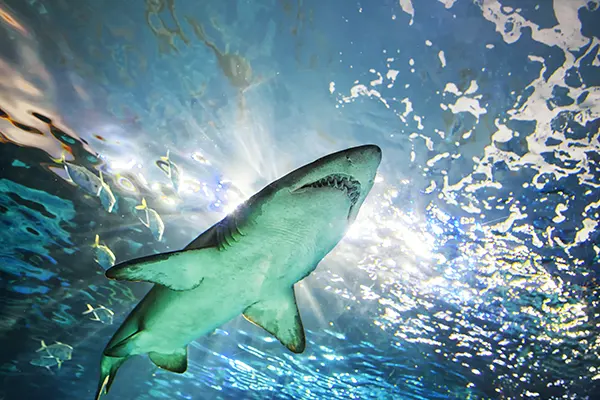Shark attacks are not common at Kaanapali Beach, although they do happen every now and then. They are also not often fatal.
But shark attacks do happen on occasion at Kaanapali, but being aware of what lurks in the murky waters is the best way to be prepared.

Has There Ever Been a Shark Attack at Kaanapali Beach?
Table of Contents
The Kaanapali neighborhood is noted for having some of Maui’s nicest beaches, making it a prominent hotel and tourism area. But it was in this area, near Honokowai Point, that a horrific shark attack happened.
In 2019, a man died in Kaanapali after a suspected shark assault: Thomas Smiley, a 65-year-old resident of Granite Bay, California.
Although his death is heartbreaking, shark specialists note that fatal attacks are quite rare.
Globally, there are about 80 unprovoked shark attacks each year, with about 16 of those in the United States. (For comparison: lightning kills about 20 people each year in the U.S.)
And looking at the incidents list, as reported by the Hawaiian government, shows that most encounters with sharks in Hawaii are not fatal.
How do you protect yourself from shark attacks?
Sharks are the ocean’s top predators, and they’ve earned the reputation thanks to annual events like Shark Week. Although our perception of sharks is more often than not skewed due to our perception of them, rather than reality.
(Know that Great White sharks only make their appearance in Maui in fall and early winter.)
Humans are occasionally bitten by sharks though not every attack is fatal. Sometimes people, accidentally grab onto a shark while floating in the water. Or, a shark might bite because it believes its territory is threatened, somewhat similar to a dog’s growl.
But, whenever you head out into the ocean for a swim it’s good to be prepared just in case sharks happen to be swimming nearby.
1. Swimming should always be done in a group. Sharks prefer to attack lone people.
2. Don’t stray too far from the beach. This separates you and keeps you from receiving help.
3. At nighttime, dawn, or dusk, stay away from the water. Most sharks are most lively during these periods, and they’re more able to locate you than are able to locate them.
4. If you’re wounded, don’t go into the water. Sharks have the ability to detect and taste blood as well as track it back to where it came from.
5. Wearing gleaming jewelry is not a good idea. The reflected light has the appearance of gleaming fish scales.
6. Do not enter sewage-contaminated waters. Sewage draws baitfish, which lure sharks in return. Also, it’s gross!
7. Avoid fishing areas and areas with a lot of bait fish. Seabirds that dive are great signs of such activity.
8. If sharks are sighted, do not enter the water. If you spot sharks, get out of there right away. Clearly.
9. Avoid a tan that is uneven and brightly colored garments. When the waters are foggy, be extra cautious since sharks can sense contrast quite well.
10. Do not splash a lot of water. Keep dogs out from the water as well. Sharks are attracted to erratic motions.
11. Keep an eye out for sandbars and severe drop-offs. These are sharks’ preferred hangout spots.
12. Don’t let the presence of porpoises fool you. The presence of porpoises does not imply the lack of sharks. Both eat similar meals on a regular basis.
13. If you encounter a shark, do not even try to touch it!
14. “Do everything necessary to get away!” is the conventional guideline when bitten by a shark. Punch the shark on the nose if you have to!
Types of Shark Bites
Provoked bites. Humans approaching sharks produce provocation bites. These are most common when fishing and the sharks have to be released from the fishing line, or when divers have to tried to grasp onto a shark, or have even tried feeding a shark (don’t do that!).
Unprovoked bites. When sharks encounter humans they might bite without provocation. This can happen in one of three ways.
- Hit-and-Run bites. Near coastlines, where sharks attempt to catch fish, hit-and-run bites occur. A shark might misinterpret the motions of humans for fish. The shark tries to grab onto a person, then releases them and flees the area. Legs or feet are frequently bitten. Injuries are typically mild, and deaths are uncommon.
- Sneak bites. Deeper seas are where sneak bites happen. Before the incident, the victim does not see the shark. The outcome might be significant harm or death, particularly if the shark attacks again.
- Bump-and-Bites. When a shark surrounds and knocks the target with its head and upper body before attacking, this is known as a bump-and-bite. The shark might approach repeatedly, as in the sneaky bite, causing serious harm or death.
Bottom Line
It’s quite improbable that a shark attack will happen to you at Kaanapali Beach. However, keep your wits about you.
Whenever there’s a lot of unclean water after a rain, don’t get in. If you go with friends, you will be less vulnerable than if you go alone. Just be cautious and have a good time.
Also, for the curious, we’ve put together an article about Maui’s dangerous animals, both in the seas and on land.
